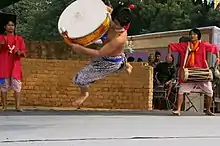Pung Cholom
The Pung cholom (Meitei: ꯄꯨꯡ ꯆꯣꯂꯣꯝ, lit. 'roar of the drum') is a traditional Meitei dance form originated from Manipur, which is the soul of the Manipuri Sankirtana music and the Manipuri classical dance.[1][2][3] The Pung cholom is a unique classical dance of Manipur. This dance may be performed by men or women and is usually a prelude to the Ras Lila.[1][2][3] In this style, the dancers play the pung (a form of hand beaten drum) while they dance at the same time. Dancers need to be graceful and acrobatic at the same time. They use these acrobatic effects without breaking the rhythm or flow of music.[1][2][3] The dance is marked by a gentle rhythm, which gradually builds up to a thunderous climax. Pung cholom borrows elements from the Manipuri martial arts, Thang Ta and Sarit Sarak and also from the traditional Maibi Jagoi.[1][2][3]


Function of eyes
.jpg.webp)
In Pung Cholom, eyes play a crucial role since every actions are done through vision. There are three different kinds of the way of looking, on the basis of the distance between the eyes and the objects to be seen.[4] The types are (1) anakpa (Meitei for 'nearby')[5] (about 2.6m of distance between eyes and objects), (2) mayai (Meitei for 'middle/center')[6] (about 4.3m of distance between eyes and objects), and (3) arappa (Meitei for 'far/distant')[7] (about 6m of distance between eyes and objects).[8]
Dances similar to Pung cholom
- Pungmul - South Korea and North Korea
- Gayan-bayan - Assam
- Khanjluri, Kazbeguri, Khevsuruli and Mtiuluri - Georgia
- Jangi - Azerbaijan
- Yarkhushta - Armenia
- Qilaut - Canada (Nunavut, Northwest Territories and Yukon), United States (Alaska), Denmark (Denmark) and Russia (Chukotka Autonomous Okrug)
- Karyenda - Burundi
References
- "Pung Cholom: There's nothing solemn about this explosive dance". Topics. Retrieved 16 January 2021.
- "Pung cholom : Also known as Mrindanga Kirtan or Dhumal or Drum Dance, Pung Cholom is a famous dance style of Manipur that involves dancing and playing a drum at the same time". Incredibleindia.org. Retrieved 26 November 2021.
- Nath, Parshathy J. (17 September 2015). "A dancing tribute to Manipur". Thehindu.com. Retrieved 26 November 2021.
- Singh, Leitanthem Santosh (10 December 2021). "THE MOTOR SKILLS FOR PERFORMING MANIPURI PUNG CHOLOM". ShodhKosh: Journal of Visual and Performing Arts. 2 (2): 151–160. doi:10.29121/shodhkosh.v2.i2.2021.49. ISSN 2582-7472.
- Sharma, H. Surmangol (2006). "Learners' Manipuri-English dictionary (Definition of "anakpa")". dsal.uchicago.edu (in Manipuri and English). University of Chicago. Digital South Asia Library. p. 7. Retrieved 16 October 2023.
1) ꯑꯅꯛꯄ anakpa (p. 7) anakpa ꯑꯅꯛꯄ /ə.nək.pə/ adj. nearby. Morph: a‑nak‑pa [Att‑to be near‑Nom].
- Sharma, H. Surmangol (2006). "Learners' Manipuri-English dictionary (Definition of "mayai")". dsal.uchicago.edu (in Manipuri and English). University of Chicago. Digital South Asia Library. p. 140. Retrieved 16 October 2023.
mayāi ꯃꯌꯥꯏ /mə.yái/ n. middle; centre. Morph: ma‑yāi [NM‑middle\centre].
- Sharma, H. Surmangol (2006). "Learners' Manipuri-English dictionary (Definition of "arappa")". dsal.uchicago.edu (in Manipuri and English). University of Chicago. Digital South Asia Library. p. 11. Retrieved 16 October 2023.
ꯑꯔꯥꯞꯄ arāppa (p. 11) arāppa ꯑꯔꯥꯞꯄ /ə.rap.pə/ adj. far; distant; not near. Morph: a‑rāp‑pa [Att‑to be far‑Nom].
- Singh, Leitanthem Santosh (10 December 2021). "THE MOTOR SKILLS FOR PERFORMING MANIPURI PUNG CHOLOM". ShodhKosh: Journal of Visual and Performing Arts. 2 (2): 151–160. doi:10.29121/shodhkosh.v2.i2.2021.49. ISSN 2582-7472.